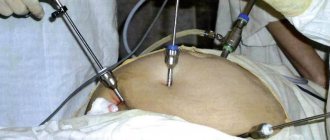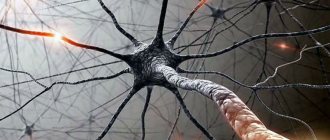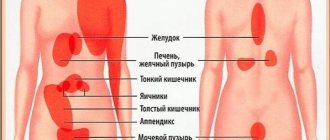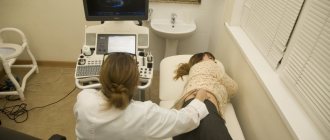Causes of pain throughout the abdomen
Bacterial overgrowth syndrome
In domestic gastroenterology, the abbreviation SIBO refers to intestinal dysbiosis. It is characterized by non-localized abdominal pain of moderate intensity, caused by the spread of the process throughout the intestine. Patients describe the pain differently: cramping, cutting, aching or dull. Often there is a bursting pain associated with bloating. Diarrhea with foul-smelling stool, nausea, and rumbling in the intestines are typical.
Enzyme deficiency
With lactase deficiency, symptoms develop 20-30 minutes after consuming dairy products. Patients feel cramping pain throughout the abdomen, which is accompanied by rumbling, flatulence, and repeated diarrhea. With isomaltase and sucrase deficiency, such manifestations occur after eating potatoes, sweet vegetables and fruits, flour products and sweets.
Celiac disease (gluten enteropathy) is less common. Failure to comply with the diet prescribed by the gastroenterologist results in constant pain and discomfort throughout the abdomen. Within an hour after taking prohibited foods, sharp spasms begin, which gradually turn into dull or aching painful sensations. Symptoms are complemented by repeated foul-smelling stools, nausea and vomiting.
Intestinal infections
The appearance of diffuse pain is observed if the infectious agent has spread throughout the gastrointestinal tract. Patients are worried about severe pain and spasms associated with the consumption of poor-quality food and water. Typically, the pain syndrome is paroxysmal in nature, its intensity decreases after defecation. In severe forms of infections, especially dysentery, pain is felt constantly, accompanied by painful tenesmus.
Helminthiasis
Pain throughout the abdomen that has been bothering the patient for several weeks can be caused by helminthic infestations - ascariasis, trichinosis, taeniasis. Often a dull pain develops, which has no clear provoking factors. When helminths move through the intestines, severe short-term colic occurs in the abdomen. If worms disrupt the passage of food throughout the gastrointestinal tract, the pain intensifies and is accompanied by constipation.
Peritonitis
In the initial period, the pain is localized in the projection of the affected organ, but after a couple of hours the pain becomes diffuse. The pain is very strong and can radiate to the lower back, shoulder or supraclavicular area. To alleviate the condition, a person lies motionless on his back or side, with his legs pulled up to his body. When moving, the pain throughout the abdomen gets worse.
When palpating the anterior abdominal wall, the pain syndrome intensifies; due to hyperesthesia, even light touches to the abdomen give the person unpleasant sensations. In addition to pain, repeated vomiting, stool and gas retention are noted. If the patient is not provided with timely assistance, the intensity of the pain gradually decreases, which indicates the terminal phase of peritonitis.
Pain throughout the abdomen
Intestinal obstruction
Characterized by sudden severe pain throughout the abdomen, accompanied by vomiting and constipation. With mechanical intestinal obstruction, abdominal pain has a wave-like course: it intensifies until unbearable with the passage of a peristaltic wave, after which it subsides for a short time. During an attack, a person groans in pain and takes forced positions (squatting, on his side, knee-elbow).
For paralytic intestinal obstruction, diffuse pain that is less intense is typical. Their character does not depend on peristaltic waves. Patients complain of painful distension and bloating. In the spastic form of the disease, cramping pain is observed throughout the abdomen. There are no signs of intoxication and dehydration, in contrast to mechanical obstruction.
Intestinal infarction
Suddenly, against the background of complete health, paroxysmal pain in the abdomen develops, which after a few hours turns into constant severe pain. Patients experience unbearable pain, they can scream and moan, rush around the bed in search of a more comfortable position. A distinctive feature is the absence of tension in the abdominal muscles - the abdomen is soft, and the pain does not increase when palpated.
Emergency conditions
Pain throughout the abdomen occurs not only with surgical and gastroenterological diseases. Sometimes they are caused by vascular pathologies and metabolic disorders. Typically, such pain begins suddenly, its intensity quickly increases, and the general condition sharply worsens. Most often, abdominal pain syndrome occurs:
- Diabetic ketoacidosis.
Characterized by severe cutting or burning pain in the abdomen without clear localization, which develops over the course of a day. Ketoacidosis is also characterized by repeated vomiting, signs of dehydration, and impaired consciousness. - Anaphylactic shock.
Symptoms appear abruptly, within a few minutes. The pain spread throughout the abdomen is combined with an increasing deterioration in well-being and a drop in blood pressure. Often the patient does not attach much importance to pain due to the general serious condition. - Dissecting aortic aneurysm.
First, the pain is felt in the chest, then, as the entire aorta is affected, it spreads to the abdominal cavity. The pain syndrome can move from the abdomen to the lower back and vice versa.
Acute intermittent porphyria
Sharp pain throughout the abdomen is typical of the manifest form of the disease. The pain is colicky in nature. As a rule, they become unbearable and resemble the clinical picture of an “acute abdomen.” In addition to pain, fever and increased blood pressure are observed. There is pain in the lumbar region, accompanied by the discharge of pink or red-brown urine.
Complications of pharmacotherapy
Discomfort and pain throughout the abdomen occur with drug-induced colitis, provoked by taking antibiotics, laxatives, and some antihypertensive drugs. Patients complain of constant pain, rumbling throughout the large intestine, and flatulence. Sometimes intense cramping pain in the left iliac region and tenesmus appear.
Mucositis occurs in cancer patients receiving radiation or chemotherapy. When the pathological process spreads from the oral cavity to the underlying parts of the gastrointestinal tract, excruciating pain develops throughout the abdomen. Painful sensations are poorly relieved by analgesics. The pain syndrome is accompanied by diarrhea, there is a lot of mucus in the stool, and streaks of blood are visible.
Rare causes
- Inflammatory processes:
omentitis, transversitis. - Purulent complications
: interintestinal abscess, intestinal phlegmon, retroperitoneal abscess. - Appendicular-genital syndrome.
- Poisoning
: arsenic, mercury, mushrooms. - Tumors of the abdominal organs
. - Connective tissue damage
: systemic vasculitis, scleroderma, dermatomyositis.
Abdominal pain
In acute abdomen, the pain is severe, constant, with a sudden onset, often accompanied by nausea and vomiting, bloating, fever and shock. As a rule, surgical intervention is required to eliminate it. Etiology Abdominal pain can be caused by inflammation and ischemia of the digestive organs, obstruction and increased pressure in the lumen of the gastrointestinal tract (GIT), stretching of the organ or spastic contraction of its muscular system. The causes of abdominal pain are presented in Table 1. Pathogenesis The following types of abdominal pain are distinguished: visceral, parietal, reflex and psychogenic. Visceral pain. Visceral pain is caused by: a) increased pressure in the cavity of the stomach and intestines when they stretch or contract and b) impaired blood supply. Visceral pain is caused by functional disorders of the organ and organic lesions. The functional component is determined by the threshold of visceral sensitivity. Visceral sensitivity varies widely and can be measured using a balloon filled with air. The pain threshold is in the range of 40–50 mmHg. Inflammation of the organ leads to a decrease in the threshold for pain sensation. In patients with irritable bowel syndrome (IBS) and other functional disorders of the digestive system, the threshold of sensitivity to mechanical, thermal and chemical stimuli is reduced and pain appears in response to subthreshold stimuli. One of the manifestations of visceral hypersensitivity is visceral hyperalgesia. Hypersensitivity can spread to all parts of the gastrointestinal tract. In the pathogenesis of visceral hypersensitivity, the main role is played by neurotransmitters, in particular serotonin, which, through the activation of 5-HT3 receptors localized on primary afferent (sensitive) neurons (neurons of the vagus nerve and spinal nerves), causes the appearance of peripheral ascending sensory impulses. In the cerebral cortex, these sensory impulses form pain sensations, which patients give a detailed description of (burning, stabbing, bursting pain, etc.).
Visceral hypersensitivity is the primary mechanism that shapes the occurrence and intensity of pain in IBS. Gradually developing visceral pain is usually dull, appears much later than the pathological focus, gradually increasing, it acquires a “gnawing” or cramping character. These features are explained by the lack of tactile sensitivity of the mucous membrane and the visceral layer of the peritoneum. Painful sensations occur when the muscle membrane, which has the endings of sympathetic nerve fibers, is stretched. In patients with pancreatitis, pain is usually localized at the level of the lower thoracic vertebrae and spreads to the hypochondrium. As a result of swelling of the gland, “packed” into a dense capsule, stretching of the latter causes unbearable pain during an acute process. In intestinal diseases, the origin of visceral pain is associated with stretching, ischemia or peristalsis of the intestine and the patient cannot accurately indicate the painful point. Usually the pain is felt in or near the midline of the abdomen, because... associated with irritation of the nerve endings of all parts of the intestine. Parietal pain is caused by irritation of the cerebrospinal nerve endings of the parietal peritoneum or the root of the mesentery. It affects the corresponding segments of the skin and is often associated with constant spasm (rigidity) of the abdominal wall muscles. This type of pain is also called somatic, since it most often results from inflammation of the parietal peritoneum or mesentery, i.e. result of peritonitis. Parietal (somatic) pain is quite severe, strictly localized in the area of the pathological process and intensifies with coughing and movements. A clear localization of pain, when the patient points to the place with a finger, is characteristic of irritation of the parietal layer of the peritoneum. This pain appears during ulcerative-destructive penetrating processes in the abdominal organs and is characteristic of inflammatory diseases in the case of transmural damage to the organ wall. Reflex (referred) pain was first studied and described by G.A. Zakharyin and N. Ged. As a result of the interaction of visceral fibers and somatic dermatomes in the dorsal horns of the spinal cord, pain sensations are reflected on the surface of the body innervated by the same segments of the spinal cord, which is manifested by Zakharyin-Ged zones of increased skin sensitivity. This pain is localized in certain areas of the body surface, remote from the pathological process. Reflex pain often occurs with diseases of the stomach, pancreas or gall bladder and is less typical for intestinal diseases. The formation of pain is influenced by the central nervous system and the enterin system with its receptor apparatus, which responds to the production of serotonin and norepinephrine. A decrease in serotonin production leads to an increase in the sensation of pain, because reduces the pain threshold, and norepinephrine, on the contrary, increases it. Psychogenic pain. Constant dull aching pain in the abdominal cavity, lasting for months and even years, without correlation with physiological functions and in the absence of objective changes in the abdominal organs, can be psychogenic. Its peculiarity is the absence of a focus that could explain the trigger of pain. Psychogenic pain is observed in individuals with psychoemotional disorders.
Features of psychogenic pain are: a) cessation or reduction in conditions of mental rest (for example, on vacation); b) absence during sleep, including nighttime, i.e. pain does not wake the patient; c) positive effect from the use of psychotropic drugs. Clinical features During a conversation with the patient, the doctor should obtain information about the characteristics of the onset and development of pain, the intensity and nature, duration and reasons for the exacerbation and subsidence of pain. The onset of pain can be sudden, gradual or slow. A sudden onset develops with the parietal (somatic) type of pain. Sudden onset of abdominal pain (within seconds or minutes) is typical of gastric or intestinal perforation, dissecting abdominal aortic aneurysm, ovarian torsion, and tubal rupture during ectopic pregnancy. The patient often takes a forced position and freezes in it. When localized in the right iliac region, sudden cramping pain may be a manifestation of mobile cecum syndrome or adhesions. In these cases, its appearance is associated with changes in body position and physical activity. Usually it is short-lived. Pain that gradually increases over several hours is observed in many diseases. When it is localized in the right iliac region, first of all, the doctor and the patient think about the possibility of acute appendicitis, which is often confirmed. Although with this disease, pain usually first appears in the mesogastrium and only after some time moves from the middle parts of the abdomen to the right lower quadrant. Gradually increasing pain in the right iliac region is characteristic of acute appendicitis, as well as inflammation of Meckel's diverticulum, low small bowel obstruction, strangulated right-sided inguinal hernia, terminal ileitis and renal colic with localization of a stone in the right ureter. In women, acute pain in the right iliac region can occur with inflammation of the appendage, as well as with ectopic pregnancy. The duration of pain matters: in acute appendicitis, the history is short. But children and the elderly may have difficulty assessing anamnestic data. In addition, we must remember about the possibility of chronic recurrent appendicitis. In this case, the patient had experienced similar attacks before, but ended on their own without surgical intervention. The gradual onset of abdominal pain is also characteristic of thrombosis or embolism of mesenteric vessels, intra-abdominal abscesses in Crohn's disease and diverticulitis of the colon. Slowly increasing pain (over several days and weeks) occurs with gradual disruption of intestinal patency due to a tumor or Crohn's disease. The onset of pain is usually preceded by a large meal or physical activity. Constant dull pain in the right iliac region is often observed with constipation and is a sign of overflow and distension of the cecum with feces. The cause of pain in the right lower quadrant may be irritation of the cecum and ascending colon by bile in the case of asynchronous contraction of the gallbladder with food. The intensity of pain usually increases with intestinal obstruction, but may temporarily decrease if patency is partially restored. The replacement of episodes of acute pain with their temporary cessation is especially characteristic of small intestinal intussusception. In acute appendicitis, the pain can also acquire wave-like intensity, and with perforation of the appendix, it can even temporarily subside due to a drop in pressure in its lumen. Increasing and decreasing pain. The connection between pain and body position is especially typical for patients with peritonitis, in whom even a slight shaking of the body causes increased abdominal pain. With ischemic abdominal syndrome, patients unsuccessfully try to find a position in which the pain would become less severe. In acute appendicitis with a retrocecal position of the appendix, the patient lies on his back with his right leg bent at the hip and knee. A patient with exacerbation of chronic pancreatitis often takes the knee-elbow position, which reduces the pressure on the pancreas of the organs and tissues located above it. Pain in diseases of the stomach, biliary tract and pancreas appears soon after eating. With pathology of the small intestine, it occurs at the height of intestinal digestion, i.e. after noon. With pathology of the left parts of the colon, pain increases before stool or due to flatulence, and decreases after the passage of gas and stool. Often, abdominal pain and the urge to defecate occur after each meal, which is associated with an increased gastrocecal reflex and is especially common in patients with IBS. Pain that intensifies after stool, when walking and shaking the body, usually indicates adhesions and inflammation of the wall of the stomach or intestines, spreading to the visceral peritoneum. In functional diseases, pain is associated with disturbances in the tone of the stomach or intestines and is perceived as dull or spastic. It occurs at different times after eating and is often provoked by emotional stress. Pain rarely wakes patients up, but often interferes with sleep. The pain may continue for many years, varying in intensity and duration from day to day, but without noticeable progression. The mechanism of such pain is associated with strong rhythmic or constant muscle contractions or distension of the intestine with gas, as well as with changes in the receptor sensitivity of the irritable intestine. On palpation, the pain points coincide with the projection of the colon. Paroxysmal pain can be the result of either a functional spasm of the stomach, gall bladder or intestines, or obstruction of the diseased organ due to a narrowing of its lumen of inflammatory or tumor origin, or the presence of a calculus in the gall bladder. Abdominal pain accompanies various diseases or damage to the central and peripheral nervous system. Irritation of the spinal cord due to curvature of the spine, displacement of intervertebral discs, arthritis, arthrosis, tuberculosis and neoplasms can cause pain in the abdominal cavity, creating significant differential diagnostic difficulties with diseases of the digestive system. Clinical manifestations of visceral hypersensitivity are symptoms of hyperalgesia and allodynia. Hyperalgesia may manifest as increased sensitivity to painful stimuli and the sensation of pain evoked by non-painful stimuli. Allodynia is a dysfunction caused by painful stimuli. Symptoms of IBS such as flatulence, impaired motility, transit and defecation are considered secondary, caused by pain syndrome. It is not always possible to determine the triggering moment that led to dysfunction of the organ. In the development of the disease, the state of higher nervous activity and the patient’s personality type are of great importance. It is believed that, based on the nature of the severity of neuropsychic reactions, patients with IBS constitute a borderline group between normality and psychopathology. Diagnosis, differential diagnosis Objective assessment of pain is difficult. Their intensity depends on a number of factors: the type of higher nervous activity, emotional background, and the environment in which the patient is located. You can objectify the intensity of pain using a visual analogue scale. Pain assessment should be carried out by the patient himself. The answer to the question: “How much pain do you feel?” can be presented in the form of a horizontal line 100 mm long with the inscriptions at the ends: “There was no pain at all” (left) and “Unbearable pain” (right). The patient is asked to answer the question by placing a mark on the line. The scale should be used in cases of clinical research. During an objective examination, it is necessary to keep in mind that pain may be associated with the skin of the abdomen and abdominal muscles. The intensity of pain in the abdomen depends on the degree of sensitivity of the nerve plexuses. The solar plexus is located deep in the abdominal cavity to the left and up from the navel. Outward and slightly downward from the navel are the mesenteric plexuses - upper to the right and lower to the left of the navel. The nature of the pain usually does not play a decisive role in the differential diagnosis. However, if the pain continues for years, is not associated with physiological functions, and the patient has no changes in internal organs that could explain it, we can assume a psychogenic genesis of pain. Correct interpretation of pain syndrome and knowledge of its characteristics in various diseases allows the doctor to preliminarily determine the correct diagnosis and treatment tactics in approximately 75–90% of patients. It is also important for the doctor to remember that abdominal pain can be caused by problems outside the abdomen, especially heart attacks and pneumonia, which can sometimes cause abdominal pain. Blood tests (general, electrolytes, urea, creatinine, liver aminotransferases, amylase, lipase) and a pregnancy test help establish the correct diagnosis; Analysis of urine; ECG and plain radiographs of the chest and abdomen. For a final diagnosis, ultrasound, contrast radiological and endoscopic examinations of the abdominal organs are also necessary. Treatment If abdominal pain occurs, especially chronic pain, patients take medications before seeing a doctor. The most commonly used drugs are drotaverine, antacids, choleretic drugs and pancreatic enzymes. Drotaverine usually has a temporary analgesic effect for spasmodic pain in the stomach, intestines and biliary tract. Choleretic and enzyme preparations can help relieve pain caused by intestinal distension by gases. The cessation of pain after taking antacids is typical for acid-dependent diseases. The principles of symptomatic therapy for pain depend on its origin. For visceral pain associated with spasms of smooth muscles, antispasmodic and anticholinergic drugs with different mechanisms of action have an analgesic effect. Traditional anticholinergic and antispasmodic drugs include atropine, drotaverine, papaverine hydrochloride, platyphylline hydrotartrate and metacin (0.002 g x 2 times a day), as well as hyoscine butylbromide, prescribed 0.01 g x 3 times a day, and the m1-cholinergic receptor blocker pirenzepine (0.05 g x 2-3 times a day), m-anticholinergic blocker dicycloverine - administered intramuscularly at 0.02 g. Currently, sodium and calcium channel blockers are more often used. Representatives of the latest generation of such drugs are mebeverine hydrochloride, pinaverium bromide and alverine citrate. Attempts to use synthetic analogues of enkephalin as motor regulators that reduce pain led to the creation of trimebutine. The effect of trimebutine is due to its effect on opioid receptors in the gastrointestinal tract. It reduces visceral hypersensitivity of the intestinal mucosa. Trimebutine is prescribed 0.1–0.2 g x 3 times a day, before meals, treatment duration is 2–4 weeks. For the treatment of patients with IBS with severe visceral hypersensitivity and psychogenic pain, tricyclic antidepressants (for example, amitriptyline) should be used. It has been established that antidepressants and antipsychotics have an effect on psychogenic pain and can increase the threshold of visceral sensitivity. Reflex (referred) pain that appears during inflammatory diseases of the digestive system can be reduced under the influence of analgesics-antipyretics, non-steroidal anti-inflammatory drugs (salicylates, diclofenac, etc.), drugs that reduce the sensitivity of nerve endings and ganglion blockers. For abdominal colic, Spazmalgon® has a good effect. Spasmalgon®. A combined drug containing metamizole sodium, pitofenone hydrochloride and fenpiverinium bromide. Metamizole sodium is a pyrazolone derivative. It has an analgesic and anti-inflammatory effect, the mechanism of which is associated with inhibition of prostaglandin synthesis. Pitophenone hydrochloride is a myotropic antispasmodic, has a direct effect on the smooth muscles of internal organs and causes its relaxation. Phenpiverinium bromide is an m-cholinergic receptor blocker that has a relaxing effect on smooth muscles. The combination of the three components of the drug leads to a mutual enhancement of their pharmacological action. Spazmalgon® is indicated for pain caused by spasm of the smooth muscles of internal organs, i.e. for colic (including renal colic, biliary colic, intestinal colic, dysmenorrhea). Spazmalgon® is available in the form of tablets and solution for intravenous and intramuscular administration. Parenterally Spazmalgon® is used for acute severe colic, administered intravenously slowly (1 ml over 1 min) 2 ml; if necessary, re-inject after 6-8 hours. Intramuscularly - 2-5 ml of solution 2-3 times a day. The daily dose should not exceed 10 ml. The duration of treatment is no more than 5 days. Before administering the injection solution, it should be warmed in your hand. Pain that appears as a result of irritation of the cerebrospinal nerve endings of the parietal peritoneum or the root of the mesentery is the result of peritonitis and is second only to narcotic analgesics (morphine, omnopon, promedol, fentanyl, tramadol, etc.).
Diagnostics
Depending on the intensity of the pain and accompanying symptoms, the patient may be examined by a surgeon, gastroenterologist, or infectious disease specialist. The doctor begins by collecting complaints and medical history, then conducts a physical examination and checks for symptoms of peritoneal irritation. To establish the cause of diffuse abdominal pain, the following laboratory and instrumental techniques are prescribed:
- Ultrasound.
Ultrasound examination of the abdominal cavity reveals a thickened and edematous intestinal wall, and sometimes peritoneal effusion is found. Duplex scanning is used to assess blood flow in the mesenteric vessels, diagnose vascular thrombosis and intestinal infarction. - Radiography
. Plain radiography is informative for confirming intestinal obstruction based on the characteristic Kloiber cups and intestinal arches. For chronic pain throughout the abdomen, it is possible to perform irrigoscopy, X-ray of the gastrointestinal tract with oral contrast to examine the intestinal mucosa. - Diagnostic laparoscopy.
If the etiology of abdominal syndrome is unclear, a visual examination of the abdominal cavity is performed through a laparoscope. The doctor detects changes in the color and vascular pattern of the intestinal wall, and identifies purulent, fecal or serous effusion. - Laboratory methods
. To exclude enzyme deficiency and inflammatory bowel diseases, a coprogram is recommended. To confirm the diagnosis of intestinal infections or SIBO, bacteriological culture of stool is done. Blood tests include a hemogram, analysis of glucose levels, urea and creatinine levels.
In practical gastroenterology, intestinoscopy is used - the “gold standard” for diagnosing SIBO. The diagnosis can be made if culture of the contents of the small intestine reveals the growth of opportunistic microflora in an amount of more than 105 CFU. If vascular pathology is suspected, CT angiography of mesenteric vessels and aortography are performed. To detect tumor processes, CT and MRI of the abdominal organs are indicated.
Palpation of the abdomen
Treatment
Help before diagnosis
If there is a possible intestinal infection, it is necessary to rinse the stomach, take sorbents, and increase the amount of fluid you drink to prevent dehydration. In case of dysbacteriosis, which is caused by antibiotic therapy, it is recommended to add kefirs and yoghurts, which contain many beneficial lactic acid bacteria, to the diet. With intense diffuse abdominal pain, the patient requires emergency medical care.
Conservative therapy
Medicines are prescribed after clarifying the causes of pain. For uncomplicated forms of intestinal infection, oral rehydration and sorbents are sufficient; taking antibacterial agents is not advisable. To eliminate abdominal pain associated with enzyme deficiency, a diet is selected that excludes foods that provoke symptoms.
For drug-induced colitis and SIBO, the first priority is to normalize the intestinal microflora with the help of probiotics and prebiotics. Medicines improve digestion, normalize stool, so discomfort and pain in the abdomen disappear. Antibiotics are indicated for severe intestinal infections and some surgical conditions to prevent complications.
Unbearable pain requires the use of narcotic analgesics to prevent the development of pain shock. For diseases of other organs and systems, manifested by abdominal pain, etiopathogenetic therapy of the underlying pathology is necessary. Those suffering from ketoacidosis undergo correction of glucose levels, acid-base and electrolyte composition of the blood. Emergency care for signs of anaphylactic shock includes the urgent administration of glucocorticoids and adrenergic agonists.
Pain above the navel
General information
Pain above the navel may be a sign of a serious illness. Often, determining the causes of pain above the navel is a very difficult task for the attending physician. In certain situations, even a consistent detailed study of the causes of pain is impossible. Often, a high-quality diagnosis and treatment prescription requires extensive experience of the attending physician, because sometimes the picture of the disease is incomprehensible.
Pain above the navel in diseases
Pain just above the belly button is usually associated with stomach problems. The following diseases may be among the culprits of this pain :
- gastritis;
- stomach ulcer;
- increased stomach acidity.
Persistent pain in this area indicates problems with the duodenum, pancreas and gall bladder.
of acute gastritis :
- nausea;
- unpleasant sensations in the pit of the stomach;
- pain above the navel;
- dizziness;
- diarrhea;
- vomit.
The mucous membranes and skin have a pale tint , the tongue has a gray coating, and the mouth is dry. Pain can also occur at night, forcing the patient to wake up and take food and medications. The pain usually subsides within the first 30 minutes after eating.
Less specific, but common symptoms of peptic ulcer disease are:
- heaviness after eating;
- feeling of fullness in the stomach;
- vomiting that brings relief;
- loss of appetite, body weight;
- heartburn.
Stomach cancer
The clinical symptoms of stomach cancer in the initial stages of the disease are unclear. Not only the patients themselves, but also their doctors often regard them as a manifestation of gastritis and, without conducting a full gastrological examination, limit themselves to prescribing appropriate medications.
At the same time, after carefully analyzing the complaints, you can detect a number of symptoms that are alarming regarding the diagnosis of cancer. The syndrome of minor signs, which includes a number of general and local symptoms, the identification of which gives reason to suspect the patient has stomach cancer . These include:
- A change in the patient’s well-being, detected several weeks or even months before visiting a doctor and expressed in the appearance of causeless general weakness, decreased ability to work, and fatigue;
- unmotivated persistent decrease in appetite or complete loss of it up to aversion to food;
- phenomena of “stomach discomfort”: loss of physiological feeling of satisfaction from eating, a feeling of fullness in the stomach, even after a small amount of food, as well as a feeling of heaviness, bloating, sometimes pain in the epigastric region and above the navel, occasionally nausea and vomiting;
- causeless progressive weight loss, accompanied by pallor of the skin, not explained by other diseases;
- mental depression - loss of joy in life, interest in the environment, in work, apathy, alienation.
The duodenum is the first section of the small intestine, about 25 cm long, into which food from the stomach enters. Ulcers occur here more often than in the stomach, but pain in the duodenum is indistinguishable from gastric pain.
Pancreatitis
Pancreatitis is a whole group of diseases of the pancreas. , inflammation of the organ occurs but enzymes still do not cease to be released. But they do not enter the duodenum, as happens in a healthy person, but begin to become active in the gland itself. In this case, treatment can be carried out either with medications or surgery.
The main manifestation of pancreatitis is pain: in the right upper half of the abdomen - when the head of the pancreas is affected. Pain in the pit of the stomach and above the navel occurs when the body of the pancreas is predominantly affected, and in the left hypochondrium when the tail of the pancreas is affected. The stool becomes liquefied. The volume of stool increases. The stool has an unpleasant odor and a foamy consistency.
In some cases, a diet for chronic pancreatitis goes well with drug therapy. This is especially true for exacerbation of the chronic form. But it is worth remembering that this or that medicine should be prescribed only by an experienced specialist, after an accurate diagnosis.
Other reasons
Duodenitis by pain in the epigastric region and above the navel - constant, dull or ulcer-like, a feeling of fullness or distension in the upper abdomen after eating, loss of appetite, nausea, and sometimes vomiting. Palpation reveals pain deep in the epigastric region.
Chronic duodenitis can be primary or secondary. Primary chronic duodenitis occurs due to poor diet (eating spicy, irritating, hot foods, alcohol), smoking.
Secondary chronic duodenitis occurs; it develops against the background of existing inflammatory diseases, for example, chronic gastritis; duodenal ulcer; improper treatment of acute duodenitis. A major role in the development of secondary duodenitis is played by duodenostasis - insufficient mobility of the duodenum as a result of obstruction or poor peristalsis. Gastroduodenitis in the acute phase is manifested by aching, cramping pain in the epigastric region and above the navel, occurring 1-2 hours after eating and often radiating to the hypochondrium (usually the right) and the navel area. Taking food or antacids reduces or stops pain. The pain syndrome may be accompanied by a feeling of heaviness, fullness in the epigastric region, nausea, and hypersalivation.
Prevention of duodenitis should include adequate and regular nutrition, limiting spicy and irritating foods, alcohol, timely detection and treatment of diseases of the digestive system, and parasitic diseases.











